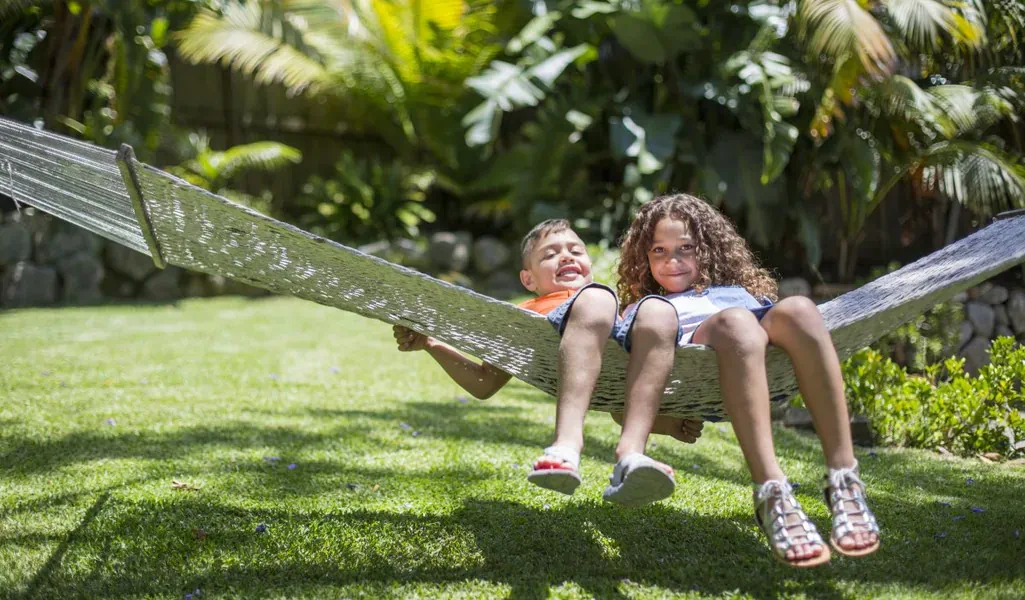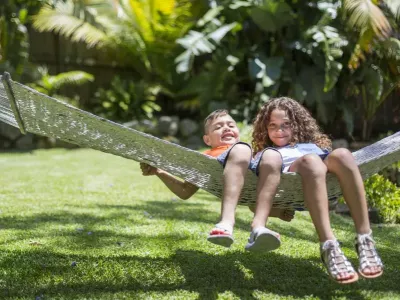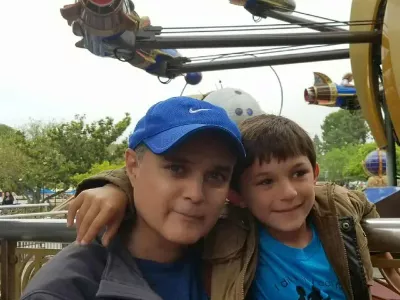Think Outside The Room

You’re reading this on a screen, so of course you know that within the past five years, we’ve had a tech revolution – smaller devices, faster internet and an explosion of games, apps and entertainment.
In a very short space of time, screen-based entertainment seems to have become the default pastime for children and adults. But while we all know how fun and useful technology can be, there’s no shortage of people raising the alarm bells about what this means for families.
The Australian Child Health Poll, by the Royal Children's Hospital Melbourne (Australia), found that most children spend more time on screens than what’s recommended. An astonishing two-thirds of primary school children and one-third of pre-schoolers have their own tablet or smartphone.
IS IT ALL ABOUT TECH?
At the same time, and not coincidentally in many ways, children spend less time than ever engaged in what’s called 'free play'. What are some of the other factors, besides changes in technology, which have brought us to this point? Well, here are a few:
- Busy and time-poor adults
- Social and peer pressure to involve kids in many extra-curricular activities
- More high-density living and fewer outdoor play areas
- Driving everywhere rather than walking or cycling
- Anxiety and (in some ways, over-hyped) fears about children’s safety.
On that last point, it’s worth noting that while we all want our kids to be safe, the reality is many parents now are afraid to leave children to manage anything for themselves, even if no harm can come to them. On the other hand, parents aren’t always aware of what kids are being exposed to online.
NOT SO SMART…
Arguably, a more competitive society and more emphasis on academic achievement has also played a part. Many children now spend more time in formal learning and tutoring from a young age. As it turns out, this can be counter-productive.
This article explains why kids who spend too much time in structured activities – and not enough time just playing and being kids – are missing out on vital experiences. As a result, they have less ability to self-regulate (manage their own impulses and emotions), plan ahead and work towards goals they’ve set for themselves. Even many Silicon Valley executives, including the late Steve Jobs, have been mindful of the impact technology could have on their children, and have set strict guidelines at home.
Are we, as many suggest, literally re-wiring our brains? It’s sobering to realise that now, even the very people who pioneered this technology are warning of its dangers.
NEW CHALLENGES, NEW SOLUTIONS
But it’s not all doom and gloom. Already, some people are tackling these problems head on and coming up with surprising solutions.
Here’s one inspirational story I read recently which sums up how a problem or challenge can be turned into something good. It’s all part of what’s called the Kindness Rocks movement, where people paint and decorate rocks and then place them in parks for others to find. Families and individuals are using the power of technology to create their own low-tech, back-to-nature fun.
Another exciting project I discovered recently is here in my home state of Queensland (Australia). It’s called Nature Play QLD, and it’s also part of a worldwide movement dedicated to helping kids, and their parents, get off the couch, away from the screens and back into the world outside.
We recently did a story on this movement in our Queensland parent publication. Through Nature Play, kids are re-discovering the joy of splashing in muddy puddles, making sand castles, climbing, digging and even arguing with each other about who’s going to be who in their latest game of pretend. Parents, too, are finding out why all this is so important; yes, even the arguing!
Hyahno Moser, from Nature Play QLD explains, and I agree, that as parents we have two roles, which need to be balanced against each other:
- Parents are the refuge (for example, if the child falls over and hurts themselves or gets a bit scared and needs reassurance);
- Parents help children to discover – to become `prospectors’, explorers, and adventurers. (In other words, parents must step back and let children drive their own play, and learn by doing and making mistakes.)
Even actions as simple as walking on an uneven or unfamiliar surface activates and strengthens new regions in the developing child’s brain. Sharing experiences with other children and learning to navigate social situations without always needing an adult to step in is also a crucial part of a healthy childhood.
WHO WANTS TO TAKE A SCREEN HOLIDAY THESE HOLIDAYS?
As it happens, I have some recent personal experience of the benefits of getting the whole family to take a screen holiday. A relative took their kids on a 12-week road trip through some of Australia’s most beautiful, but remote, areas. Most of the time they were camping and had no access to power or the internet.
For the first three days, the children were not all that happy with the lack of technology. But pretty soon, they were returning to simpler pursuits: building structures out of sticks, watching leaves float down the river, turning stones into games, and having real conversations with their parents. They spent more time joking, singing, and telling stories. In short, they were doing things that created memories and bonded them more closely together than any amount of time sitting in the same room but each absorbed in their own device.
We can even turn technology on its head by using all the incredible resources available via the internet to plan family activities that don’t involve screens.
I love the idea of a nationwide, or even global, movement dedicated to encouraging families to take a screen holiday together. Over the Christmas/New Year break seems like perfect timing. Maybe I’ll just plant the seed here in this blog and we’ll see what grows.

